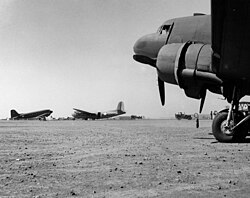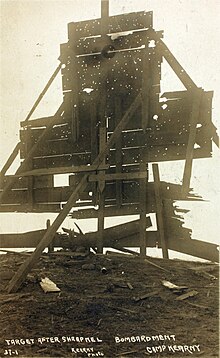Camp Kearny
32°51′58″N 117°06′11″W / 32.8659831°N 117.1030354°W
| Camp Kearny | |
|---|---|
| San Diego, Southern California | |
 View of the flight line at Camp Kearny, 1945 | |
| Type | United States Army installation |
| Site history | |
| Built | 1917 |
| In use | 1917–1946 |
Camp Kearny was a U.S. military base (first Army, later Navy) in San Diego County, California, on the site of the current Marine Corps Air Station Miramar. It operated from 1917 to 1946. The base was named in honor of Brigadier General Stephen W. Kearny.
History

Establishment and early years

The camp was established by the Army in 1917 on 12,721 acres (51.48 km2) of land on a mesa north of San Diego.[1][2] The area included the 2,130-acre (8.6 km2) Miramar Ranch, which had originally been established by newspaperman E. W. Scripps and later sold to the Jessop family.[3] It was Scripps who named the area Miramar, meaning "view of the sea".[4]
The new base was named in honor of Brigadier General
After the war, the camp was used as a demobilization center;
In 1932 the Navy installed a mooring mast for
In 1940 the Navy began a series of projects to improve and expand Camp Kearny. By 1941 the base contained more than 26,000 acres (110 km2).
United States Marine Corps use
In 1934 part of the base was leased to the

The Marines also developed a training base on the grounds of Camp Kearny called Camp Holcomb,[11] named for Major-General Thomas Holcomb who was then commandant of the Marine Corps. By 1940 the number of volunteer recruits was overwhelming the local training base, Marine Corps Recruit Depot San Diego, so the Marines replaced Camp Holcomb with a much larger training base directly east of Camp Kearny which was called Camp Elliott, named for George F. Elliott, a former commandant of the Marine Corps.[12]
After the end of the war, the Navy used Camp Kearny for demobilization. On 1 May 1946, the Navy departed Camp Kearny, handing it over to the Marines, and the station became MCAS Miramar. In 1947, the Marines moved to

Rosedale Naval Outlying Landing Field was built as Rosedale Field in 1938 just south of Camp Kearny. Rosedale Field was used for
See also
- California during World War II
- List of United States Marine Corps bases
References
- ^ a b c d e f "Historic California Posts: Marine Corps Air Station, Miramar". Militarymuseum.org. Retrieved 26 January 2010.
- ^ ISBN 978-0-932653-72-7.
- ^ a b "Powered by Google Docs". Retrieved 26 January 2010.
- ISBN 978-0-932653-73-4
- ^ "Historic California Posts: Camp Kearny (San Diego County)". Militarymuseum.org. Archived from the original on 31 May 2014. Retrieved 10 June 2014.
- ^ "McKnight for High State Guard Post," Los Angeles Times, 18 November 1919, page II-1
- ^ Barber, J. Frank (1922). History of the Seventy-Ninth Division, A. E. F. During the World War: 1917–1919. Lancaster, PA: Steinman & Steinman. pp. 7–8.
- ^ a b "Miramar History". Miramarairshow.com. Archived from the original on 2 December 2009. Retrieved 26 January 2010.
- ^ "This Day in History 1933: Dirigible crash kills 73". History.com. Archived from the original on 10 February 2010. Retrieved 26 January 2010.
- ^ "Moffett Field". History.sandiego.edu. Archived from the original on 17 May 2008. Retrieved 26 January 2010.
- ISBN 1-55750-531-4.
- ^ "Historic California Posts: A Brief History of the U.S. Marine Corps in San Diego". Militarymuseum.org. Archived from the original on 24 April 2013. Retrieved 10 June 2014.
- ^ Abandoned & Little-Known Airfields: California - Southern San Diego area
